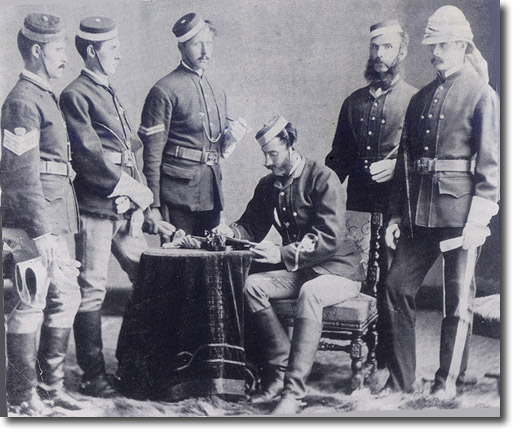|
|

 |
|
When the NWMP started up, Sir John Macdonald demanded that the uniforms be kept simple and practical; this photo shows that his wishes were complied with. The first tunic adopted by the NWMP was the scarlet Norfolk jacket which was worn by officers and men alike. This jacket was not new, it was Militia issue in Canada in the1860s. It was made from scarlet serge with a wool lining. The buttons were brass, inscribed 'NWMP'. There were large hip pockets with pointed flaps and loops to keep the belt in place. The shades of grey in old photos are deceptive as blue red and yellow all look the same. The small stand up collar, here looks as if it is red like the rest of the jacket but it is in fact blue. see Constable 1874 Two of the figures have the collar up while the others have it turned down with the top button undone to reveal the white shirt collar.
Having said that the jacket was worn by all ranks, it will be apparent that the man sitting has a gold Austrian knot on his sleeve. He is an officer, Sub-Inspector John French. He was the brother of the Commissioner George Arthur French and was killed at the battle of Batoche in 1885. His jacket shows no signs of any rank badge. The only other officer in this group is the man standing directly behind French, with heavy whiskers. His name is Francis Dickens, also a sub-inspector, and the son of the author Charles Dickens. His sleeves cannot be seen, it looks as though he is wearing the white gauntlets and carrying a cane. His top button is open and he is not wearing a leather belt like the others, but a scarlet cloth belt with two buttons. There are two NCOs in the group. The man on the extreme left seems to have four chevrons with a crown above. This denotes the rank of Sergeant-Major. The man third from left is a corporal. The sergeant-major's blue pillbox cap has a gold lace capband like Sub-Inspector French, and there is braided decoration on the top of the cap but it is not bright as one would expect of gold braid. We cannot see the top of French's cap but he does have gold piping round the top edge and the gold netted button in the middle. The caps worn by the others are also blue but have a white capband. This is to be expected on the lower ranks but Dickens appears to have the same kind of cap. The gold lace on French's and the Sgt-major's cap is about one and a half inches wide whereas the white capbands are an inch or inch and a quarter wide. The man on the right who looks as if he should be an officer must be a plain constable. There is no Austrian knot showing above his gauntlet and he wears the same brown leather belt as the other constable (second from the left). His shirt collar is the stiff upright type which one would not expect on an other rank. His white helmet is adorned with a pagri which is also surprising. He, like two other figure in the group, wears blue trousers with a double white stripe. The other two are Dickens and the corporal, so again, these were worn by all ranks. The others wear breeches which are either buff or flesh-coloured with black boots (in full dress - brown boots for field work). |
Armed Forces | Art and Culture | Articles | Biographies | Colonies | Discussion | Glossary | Home | Library | Links | Map Room | Sources and Media | Science and Technology | Search | Student Zone | Timelines | TV & Film | Wargames
